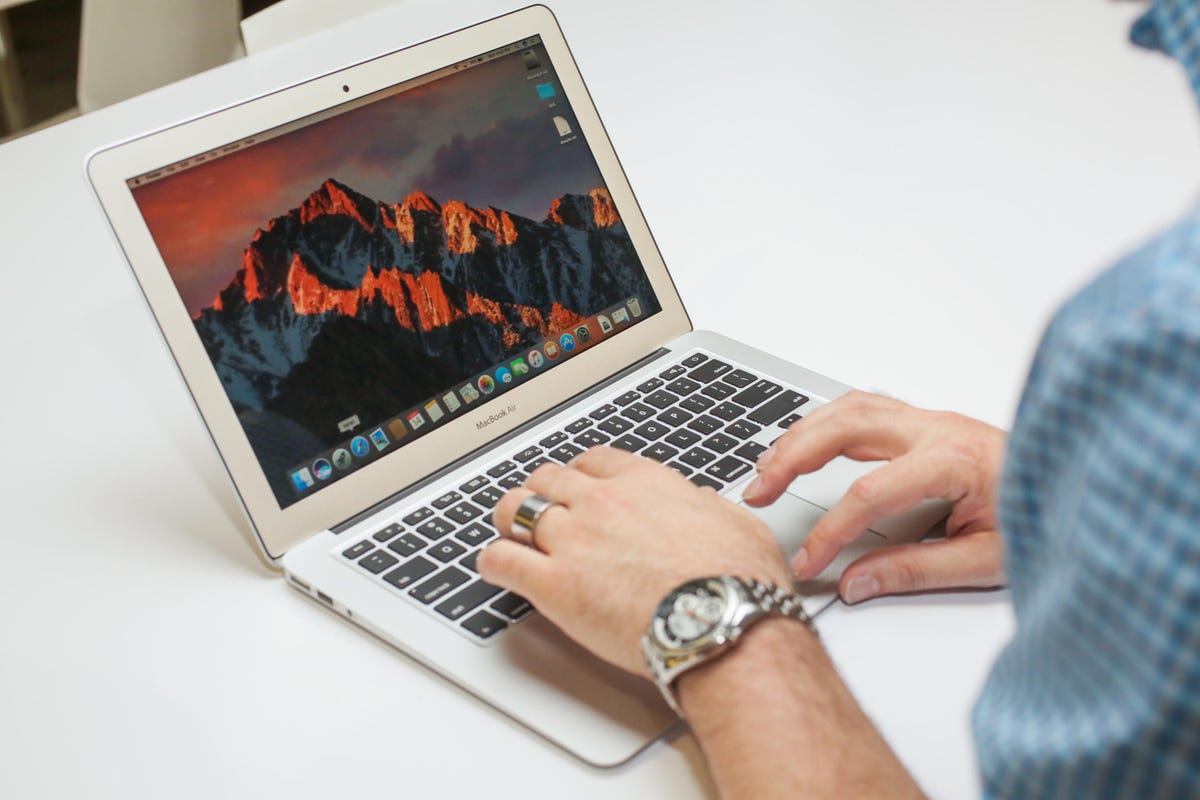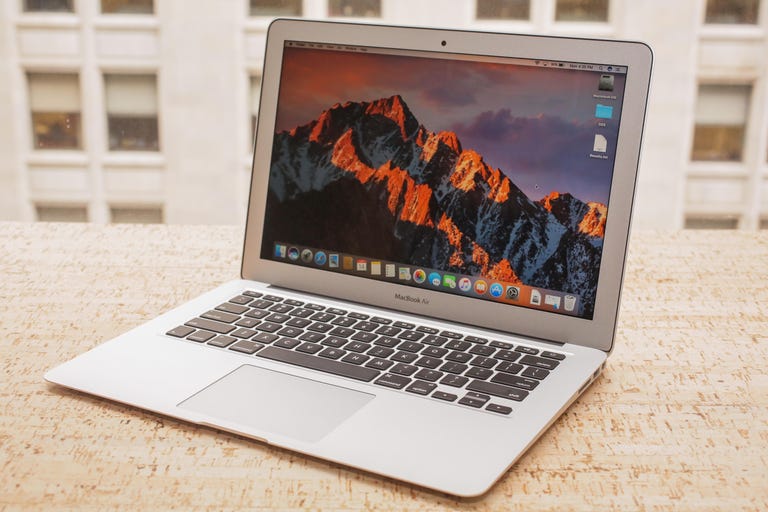 Why You Can Trust CNET
Why You Can Trust CNET Apple MacBook Air (2017) review: An old friend shows its age
The 13-inch Apple MacBook Air doesn't have much new under the hood, but it remains the least expensive way to get a Mac laptop.
Editors' note, Oct. 31, 2018: Apple has announced a new version of the MacBook Air, which starts at $1,199 (£1,199, AU$1,849) and features a Retina display, Touch ID and USB-C ports. The version reviewed below remains on sale, for now, and still starts at $999 (£949, AU$1,499). The original review, published on Aug. 17, 2017, follows.
The Good
The Bad
The Bottom Line
Apple 's MacBook Air is as close to iconic as a piece of consumer technology gets. It's the single laptop model you're most likely to see everywhere, from college campuses to airports to coffee shops and even offices. And it's been that way for a very long time.
That's the problem. Not counting an incremental spec bump in mid-2017, this is still internally almost the same MacBook Air as the last refresh in 2015, and externally, it's had basically the same design since 2010 (when the original 2008 design got an overhaul). In technology terms, that's roughly forever.

But it's also a testament to what a strong product the Air was in its heyday. To have a laptop that looks and feels the same as it did for so many years while still a maintaining a loyal following, that's a rare achievement. The MacBook Air is no longer the best-for-almost-everyone device it once was, but it's the least expensive way (by far) to get MacOS on a laptop, so there's certainly still a place for it. Note that the Air we tested had a Core i7 CPU and 256GB SSD upgrade, for a total of $1,349, £1,234 or AU$2,039. The Air still starts at $999, £949 and AU$1,499, and can be found for even less online.
SYSTEM NAME
| Price as reviewed | $1,349, £1,234 or AU$2,039 (starts at $999, £949 or AU$1,499) |
|---|---|
| Display size/resolution | 13-inch, 1,440x900-pixel display |
| CPU | 2.2GHz Intel Core i7-5650U |
| Memory | 8GB DDR3 SDRAM 1,600MHz |
| Graphics | 1,536MB Intel HD Graphics 6000 |
| Storage | 256GB SSD |
| Networking | 802.11ac Wi-Fi wireless; Bluetooth 4.0 |
| Operating system | MacOS 10.12.6 Sierra |
Still kicking
And a lot about the MacBook Air still works. As a long-time Air user, but also someone who hasn't spent a lot of time on one over the last few years, firing up the 2017 version felt like visiting an old friend.
There's the just-right size of the 13-inch screen, still the best balance between viewability and portability; the rock-solid aluminum body, which can stand up to years of abuse; and the chunky island-style keyboard, itself now extinct across the rest of the MacBook line, replaced by super-shallow butterfly keys that lack this level of tactile feedback.
The Air also scores points for being the last MacBook with a good, old-fashioned USB-A port. You know, the kind that every mouse, memory key and other accessory you own fits into. The MacBook Pro and the 12-inch MacBook have both gone all-in on USB-C, which is forward-looking to be sure, but a limiting frustration for many.
Picking it up, I was reminded of another reason I loved this particular laptop line for so long: the MagSafe power connection. The plug, which automatically pulls away from the body when you yank the cord or trip over it, remains one of the most brilliant bits of consumer PC engineering ever.
It's since been replaced by USB-C power connections, which are handy for sharing data, power, video and other connections through the same port, but not nearly as flexible. That classic MagSafe has rescued many, many laptops from a grim fate over the years, and that's just the ones I've personally almost killed.
Feeling its age
But using a MacBook Air, even a brand new one, in 2017 feels like getting stuck in a bit of a time warp. The processor is years out of date compared to newer slim laptops -- even though the big update for 2017 is a slight base CPU uptick, from a 1.6GHz Intel Core i5 to a 1.8GHz one, or in our case, an optional 2.2GHz Core i7. All are from the same fifth generation of those chips, while Intel is about to announce details of the upcoming eighth-generation Core CPUs.
I'd argue that for websurfing, video streaming and social media, it's not a huge deal to have an older-generation processor, but for a thousand bucks and up, you're not wrong to want something newer. It is great, however, to get 8GB of RAM as the default now, over the previous 4GB. The optional Core i7 in our test system helped the Air keep pace with, or beat, some slim laptops with newer Core i5 CPUs. But much more importantly, the Air is still a battery life king, running more than 10 hours.
A 13-inch Pro vs. the 13-inch Air in a battle of the bezels.
The single biggest thing that keeps the MacBook Air stuck in the past is its display. This is a 1,440x900-pixel display, the same as the Air has used for many generations. It's also not an IPS display, the in-plane switching technology found in newer laptops that helps with off-axis viewing. For anything above an ultrabudget laptop, it's not wrong to expect a higher resolution, especially in 2017, where even bargain basement televisions have 4K panels, and a growing number of midrange laptops are shooting past 1,920x1,080 towards 2,560x1,440 or even 4K.
So many new devices have shaved down the bezel, which is what we call the outer border around the screen. TVs and phones are nearly bezel-free today, and high-end laptops like the Dell XPS 13 or Samsung Notebook 9 are following the same path. By comparison, the wide silver border around the 13-inch MacBook Air screen may be the single most dated thing about the design.
Two years ago, I said: "On the Air, you have a very thick bezel, the dead space between the edge of the display and the edge of the lid ... giving you a less premium look and feel." The feeling is even more pronounced now, especially as the MacBook and MacBook Pro combine great higher-resolution screens with much thinner borders.
It's a price thing
I know it sounds like I've judged the MacBook Air harshly for not keeping up with the times, but there's an important mitigating factor that could still make it the right choice for a great many shoppers.
The original MacBook Air launched in 2008 (with a single USB port and a slow non-SSD hard drive!) at $1,799 in the US. Over time that came down to $999 for the base 13-inch Air, which is where it still sits today. That's $300 less than either a 12-inch MacBook or the lowest-end 13-inch MacBook Pro (both start at $1,299, £1,249 or AU$1,899), making this the most affordable MacBook by a wide margin.
Spending around the same on a new Windows laptop will get you a better display, newer processor and probably more RAM and SSD storage (and even a hybrid hinge and touchscreen) -- but if you're determined to buy a MacOS laptop over a Windows 10 one, this is the least expensive option.
From left to right, the MacBook Pro, MacBook Air and MacBook.
Even better, while Apple sells the 13-inch MacBook Air for $999 and up, it's often easy to find at many US retailers for $899 or less, or $100 off the higher-end 256GB SSD configuration. Pre-2017 models, which are essentially identical in almost every way, can be found for as little as $799.
Years ago, I called the MacBook Air the most universally useful laptop you could buy, because of its great design, long battery life and decent specs. Today, its appeal isn't quite as broad, and the design is definitely showing its age. But the lower prices available from some retailers, plus performance that's decent enough and battery life that still tops 10 hours, has given the Air another shot -- perhaps its last one -- at avoiding the old laptop retirement home.
Multimedia Multitasking test 3.0
Geekbench 4 (Multi-Core)
Streaming video playback battery drain test
System Configurations
| Apple MacBook Air (13-inch, 2017) | Apple MacOS Sierra 10.12.6; 2.2GHz Intel Core i7-56500U; 8GB DDR3 SDRAM 1,600MHz; 1,536MB Intel HD Graphics 6000; 256GB SSD |
|---|---|
| LG Gram (13-inch, 2017) | Microsoft Windows 10 Home (64-bit); 2.5GHz Intel Core i5-7200U; 8GB DDR4 SDRAM 2,133MHz; 128MB dedicated Intel HD Graphics 620; 256GB SSD |
| Microsoft Surface Laptop | Microsoft Windows 10 Pro (64-bit) 2.5GHz Intel Core i5-7200U; 8GB DDR3 SDRAM 1866MHz; 128MB (dedicated) Intel HD Graphics 620; 256GB SSD |
| Lenovo IdeaPad Yoga 720 | Microsoft Windows 10 Home (64-bit); 2.5GHz Intel Core i5-7200U; 8GB DDR4 SDRAM 2,133MHz; 128MB dedicated Intel HD Graphics 620; 256GB SSD |
| Apple MacBook (12-inch, 2017) | Apple MacOS Sierra 10.12.5; 1.2GHz Intel Core m3-7Y32; 8GB DDR3 SDRAM 1,866MHz; 1,536MB Intel HD Graphics 615; 256GB SSD |
| Apple MacBook Pro (13-inch, 2016) | Apple MacOS Sierra 10.12.1; 2GHz Intel Core i5-6360U; 8GB DDR3 SDRAM 1,866MHz; 1,536MB Intel Iris Graphics 540; 256GB SSD |


